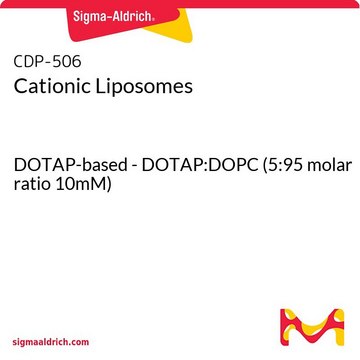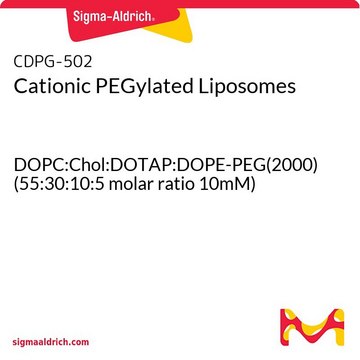CPGG-502
Anionic PEGylated Liposomes
DOPC:Chol:DOPG:DOPE-PEG(2000) (60:30:5:5 molar ratio 10mM)
Sign Into View Organizational & Contract Pricing
All Photos(1)
About This Item
UNSPSC Code:
12352211
NACRES:
NA.25
Recommended Products
Quality Level
composition
Phosphate buffered saline
concentration
10 mM
impurities
30 mol % Cholesterol
5 mol % DOPE-PEG2000
5 mol % DOPG
60 mol % DOPC
particle size
100 nm
pH
7.4
Looking for similar products? Visit Product Comparison Guide
Related Categories
General description
Poly(ethylene glycol) (PEG) is commonly added to liposomes to improve stability, hydrophilicity and enhance circulation time. Anionic PEGylated liposomes protect liposomes from circulating proteins, improving their plasma clearance and enhancing their therapeutic effects. In addition, anionic liposomes demonstrate greater stability in solution, lead to lower aggregation when compared to neutral liposomes, and have increased endocytosis when compared with cationic and neutral liposomes.
Application
Drug delivery
Lipid-protein interactions
Lipid-protein interactions
Storage and Stability
Liposomes should never be frozen. Liposomes should be stored in the dark at 4°C, except when brought to room temperature for brief periods prior to use.
Liposomes are made under sterile conditions. If you need to take multiple aliquots out of the vial, it is advised to take extreme care in not contaminating the vial. It is recommended to handle the vial under a sterile hood to maintain the sterility of the product. Liposomes should never be frozen. Ice crystals that form during freezing will rupture the lipid membrane of the liposomes and change the size of liposomes particles.
Liposomes are made under sterile conditions. If you need to take multiple aliquots out of the vial, it is advised to take extreme care in not contaminating the vial. It is recommended to handle the vial under a sterile hood to maintain the sterility of the product. Liposomes should never be frozen. Ice crystals that form during freezing will rupture the lipid membrane of the liposomes and change the size of liposomes particles.
Legal Information
Cellsome is a trademark of Encapsula NanoSciences
Product of Encapsula Nanosciences
Disclaimer
For research use only
Storage Class Code
12 - Non Combustible Liquids
WGK
WGK 2
Flash Point(F)
Not applicable
Flash Point(C)
Not applicable
Regulatory Information
新产品
Choose from one of the most recent versions:
Certificates of Analysis (COA)
Lot/Batch Number
It looks like we've run into a problem, but you can still download Certificates of Analysis from our Documents section.
If you need assistance, please contact Customer Support.
Already Own This Product?
Find documentation for the products that you have recently purchased in the Document Library.
Our team of scientists has experience in all areas of research including Life Science, Material Science, Chemical Synthesis, Chromatography, Analytical and many others.
Contact Technical Service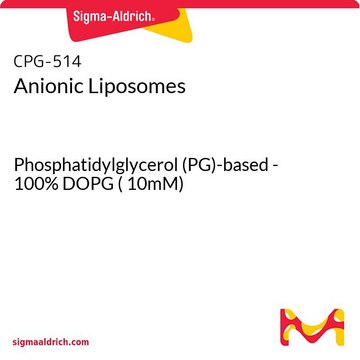
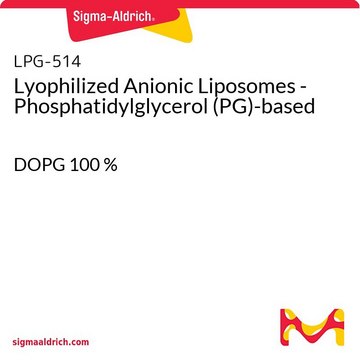
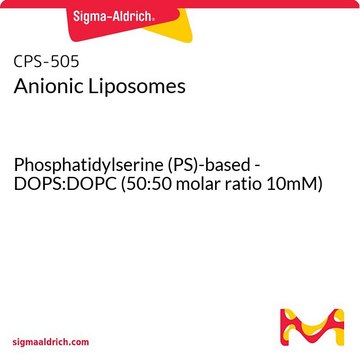
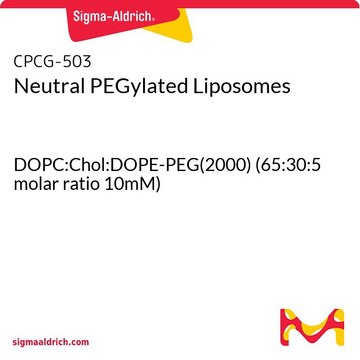
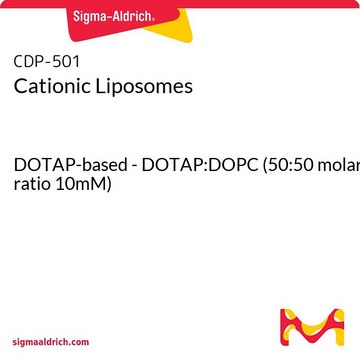
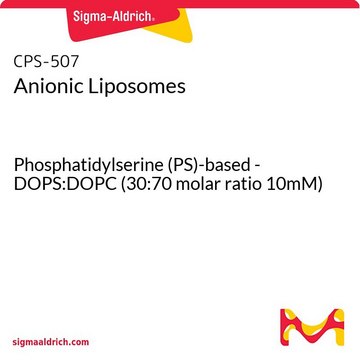
![18:1 Lysyl PG 1,2-dioleoyl-sn-glycero-3-[phospho-rac-(3-lysyl(1-glycerol))] (chloride salt), powder](/deepweb/assets/sigmaaldrich/product/structures/293/926/aa70270a-36be-4732-892e-85966f4dddf1/640/aa70270a-36be-4732-892e-85966f4dddf1.png)

